Colombia (North)
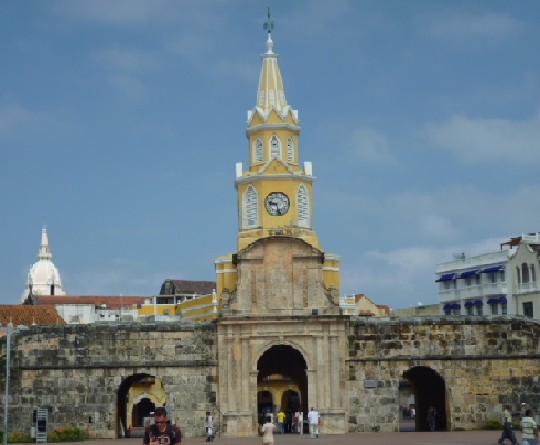
The Walled City Of Cartagena
In the early hours of the morning I left Cartagena with Kyle and David, fellow passengers from the Stahlratte, the boat that brought us from Panama to Colombia. They were filming their travels for Chinese TV with Kyle, the Chinese front of camera TV celebrity and David, the cameraman. They were heading to Santa Marta to film a scheme set up to try and persuade farmers to switch from growing the lucrative though illegal coca plant (the raw ingredient of cocaine) to organic, fair trade coffee. I was heading to nearby Minca, a small village in the foothills of the Sierra Nevada de Santa Marta mountains. David did some filming of Kyle and I eating breakfast at a roadside café, its harder than you think eating scrambled egg and talking with potentially billions of Chinese watching you through the camera lens. As we were riding alongside the Caribbean coast we stopped to get some action footage of Kyle and I on our bikes with us riding out of sight from the camera, turning around to ride past the camera then doing the same from the opposite direction. All exciting glamorous stuff!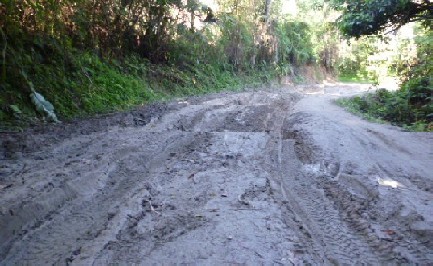
A Muddy Section Of The Road To Minca
The narrow road from Santa Marta to Minca deteriorated as it climbed up from the coast with more potholes than tarmac by the time I arrived. I had hoped to find cooler weather in Minca but the increase in altitude wasnt sufficient to make a noticeable difference and the road beyond Minca was too badly damaged from the heavy rainfall of one of the worst wet seasons in Colombias history to venture further into the mountains.
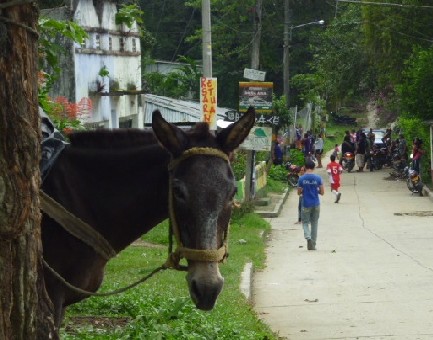
Minca Street
Compared to the Central American countries Colombia is huge with much longer distances between destinations. On the long, 423 mile (677 km) haul south to Barichara, most of it on the busy Pan Americana Highway, the traffic was brought to a halt by a tanker that had run off the road. As the motorcyclists congregated at the front of the waiting traffic I got talking to two coal miners heading to work who said that the accident had happened three days ago and we just happened to be unlucky enough to arrive shortly after the breakdown trucks were attempting to pull the tanker back up the embankment. Amazingly I was told that the driver had escaped unhurt. When I walked up to take a closer look there was a guy chest deep in a pool of whatever the tanker had been carrying trying to attach a cable to winch the tanker out. The liquid turned out to be palm oil which had been drained to reduce the weight although while I was there the two recovery trucks hadnt been able to move the tanker at all. After a couple of hours standing around in the intense heat the recovery vehicles moved to the side of the road to allow an ambulance with flashing lights and siren to come through from the opposite direction. Mayhem then ensued as the oncoming traffic tucked in behind the ambulance and followed it through with the traffic going in my direction inching forward whenever a gap appeared. Eventually the police gave up trying to hold the traffic back and we were moving again.
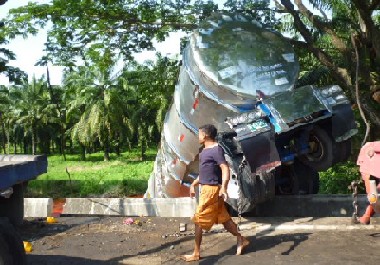
Tanker Crash On The Minca To Barichara Road
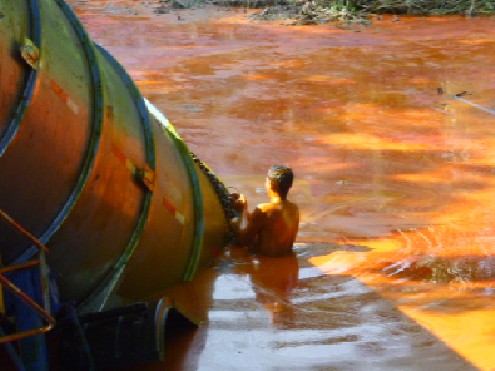
Breaking Every UK Health And Safety Rule There Is
The speciality dish of the small colonial town of Barichara is fried ants so I didnt dare go into a restaurant until I had learnt the Spanish for the dish to ensure that I didnt order it by mistake. Some people like to try any exotic local dishes and I am happy trying new dishes prepared from familiar ingredients but having gone this far in my life without knowingly eating ants, grasshoppers, snake etc. etc. I can happily forgo the experience.
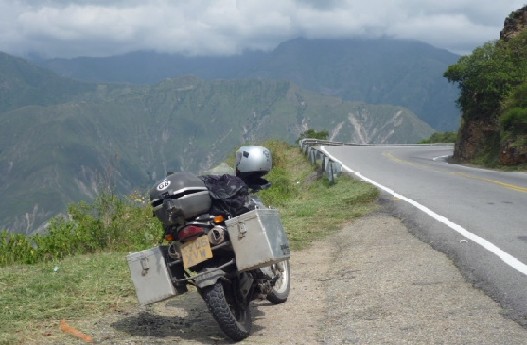
Road To Barichara
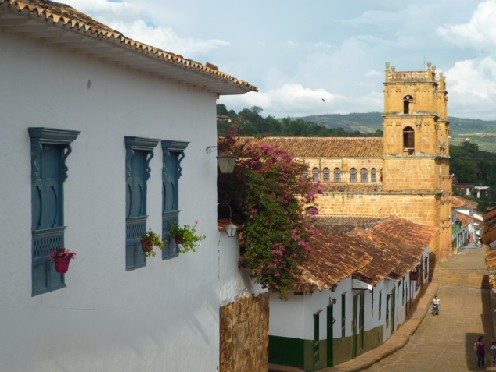
Barichara
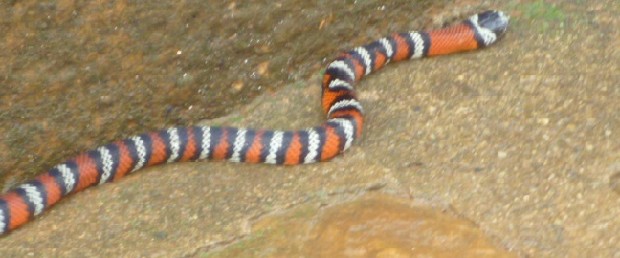
Unidentified Snake On Barichara Street
Travelling further south in the rain, again mainly on the Pan Americana Highway with all the slow moving trucks to Villa de Leyva the traffic was at a standstill for contra-flow road works. I rode past a long line of stationary vehicles to the front of the queue and although I had to wait a while; thought that once I was moving again I would have a clear road ahead of me. And so I did for three kilometres; then I was flagged down at a police checkpoint, the first time I had been stopped in Colombia. All my documents were checked although it was obvious the policeman didnt have a clue what he was looking at. He was friendly enough but kept me there until the long line of trucks had overtaken me so it was back to breathing in the diesel fumes again. The 153 mile (245km) journey took five and a half hours.
One nice thing about Colombian roads, the tolls are free for motorcycles. There is a narrow motorcycle lane that bypasses the toll booths, so much better and quicker than having to remove the riding gloves and fish around for change.
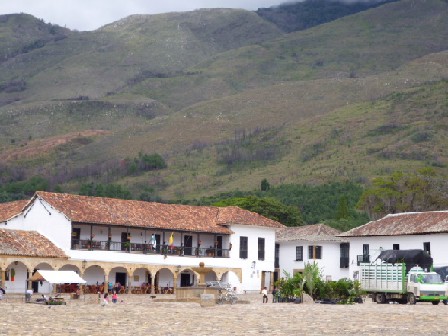
Villa de Leyva, One Of The Largest Plazas In South America
Villa de Leyva is another small colonial town with cobbled streets and one of the largest town squares in South America. A popular destination for local and foreign tourists. At the weekend a horticulture market was set up in the main square creating a colourful display.
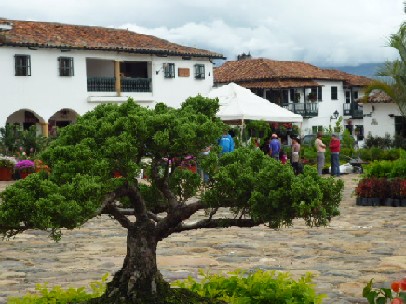
Villa de Layva Plaza With Weekend Horticulture Market
The Stahlratte motorcycle group continued to keep in touch via emaiI as we scattered southward giving each other advise on places and roads to visit or avoid. Greg who was already well south sent an email saying that he had taken a paved secondary road south from San Augustin to the small town of Mocoa then continued on a dirt road towards the Ecuadorian border. Two hours later another email arrived from Arno, a French diving instructor who lives in Panama City and had visited Colombia before. He had been talking about routes with Colombian friends when one of their phones rang. It was a call to say that a friend of his brothers had just been kidnapped in Mocoa where Greg had recently visited. I have been following the security situation in Colombia on the news and there does seem to be an increase in activity by FARC and the other freedom fighters / terrorists over the last few months. Since the government clampdown it is estimated that FARC membership has been reduced from 30,000 to 9,000 and they are restricted to the more remote border regions and the Amazon basin, these danger areas are classified as red zones. Mocoa, being close to the border with Ecuador and on the mountainside leading down into the Amazon basin is classified as a red zone.
Always one for pushing the fun envelope to the maximum, A few days after riding through a Colombian red zone Greg posted some photographs of his F800GS that had gone over a cliff. Fortunately Greg had abandoned ship beforehand and a tree fifteen feet below the road had stopped the bike disappearing from view. A pannier had fallen off (a bit worrying) which caused the bike to veer towards the drop. With local help the bike was recovered and there was no significant damage.
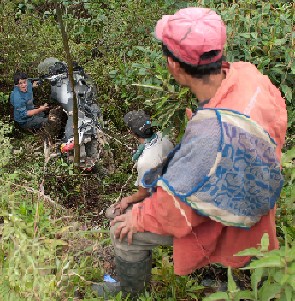
You Know Your Having A Bad Day When The Good News Is That Your Bike Landed On Top Of A Tree Instead Of Plunging Down The Mountainside
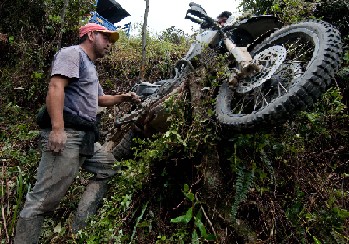
Recovering The Bike
Discussing the next leg of my trip to Guatape with the Ville de Leyva hostel manager he advised against the direct route due to the road being damaged by rain and a little trouble with guerrillas. The revised route was quite a bit further but I have seen enough washed out secondary roads to know that they are too rough for me and I dont want to risk even a little trouble with the guerrillas.
I set off from Villa de Layva toward Guatape at 6am while it was still cool but I was also hoping that I might be able to do the 250 mile (400km) ride in a day although not seriously expecting to do so. Following the hostel manager's recommended route, the first 39km turned out to be a dirt road, negotiable but slow going for the first 30km but the last section was very rough, steep and rocky. This idea of mine that you can always turn around if the track gets too bad doesnt seem to work too well, having taken two hours to do the first 30km and with only nine more kilometres to go the temptation to push on and hope that the track will improve round the next bend won out over spending a further two hours retracing my route back to where I had started. While inching the bike down hill over the rocks I came across a house and stopped to ask how much further the bad road continued although turning the bike around and riding back up the hill wouldnt have been easy if I was to retreat. A young couple came out and said it was bad for a few kilometres but then improved once the road reached the valley bottom. I set off inching downhill again with the couple helping by clearing rocks out of the way. I was getting pretty tired and hot after a while and the Colombian guy asked if I wanted him to ride the bike for a bit. I figured a younger, fitter, longer legged rider was bound to be better than me, tired as I was so we switched rolls with him gently lowering the bike downhill on the front brake while his wife and I cleared the track. He dropped the bike three times, bending the gear lever on one occasion but I would have dropped it more than that and possibly would have had to camp at the roadside to rest and continue the following day if I had been on my own. Eventually we got to the valley bottom where the road improved. I would have had a hell of a job getting through that section on my own and was really grateful for the help I received. The track was still slow going with mud replacing the rocks and I was pleased to reach the paved road going into Barbosa.
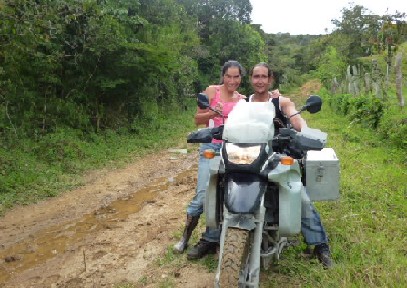
My Colombian Helpers With The Bike Back On The 'Good' Road
The paved road west of Barbosa turned into a dirt road which turned into long sections of mud which had me and the bike covered in the stuff. The tyres were coping well in the mud and I was making steady progress until I went into a deep rut where I had to lift both legs up to keep them above the ground either side of the rut. The rut got a little deeper, getting to around 18 inches (450cm) deep and one of the additional touratech fuel tanks dug into the ground at the side of the rut bringing me off. I was only doing 10mph or so but the tank mounting tube was bent back a couple of inches, one of the panniers was bent out of shape (again) and the brake pedal was bent. When I finally reached the main I45 road I decided to stop at the next hotel, this turned out to be a pricey $30 but it had off street parking, air conditioning and a swimming pool. The first thing I did once I was in the room was step into the shower wearing my bike cloths and boots to wash the mud off, the second thing I did was clean the shower cubicle! I had travelled 147 miles (235km) in nine and a half hours, the only stops were to move rocks, scout the deeper mud and water pools and to pick the bike up when it fell over, thats an average of 15mph (24kph).
The Colombians are used to these road conditions and just seem to accept them as they are, certainly the Colombians I asked had a different concept of a passable road to mine. Reluctantly I have decided that for the rest of the wet season at least I am going to have to stick to the main roads with all the slow moving trucks.
Having revised the second half of my route to Guatape to avoid a secondary road that might have been fun or might have made me feel like a feeble old man I stuck to main roads all the way which got me there in reasonable time, 155 miles (248 km) in 4.25 hours including a breakfast stop.
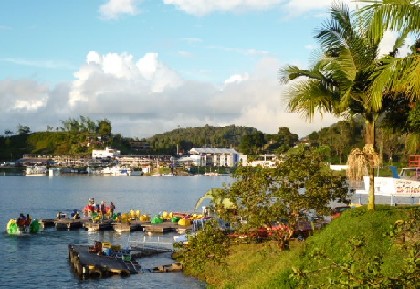
Guatape Lake
I arrived in Guatape to find it incredibly busy with gridlocked roads and packed pavements. It was a Monday and I hadnt realised it was a three day weekend. Guatapes cool climate, lake and being only an hour and a half from Colombias second city Medellin makes it a popular destination for Colombian and foreign tourists. Tuesday saw normalcy resume as most of the tourists had returned to work.
With the help of Lake View Hostel Co-Owner Greg I found a metalworker in Guatape who straightened the Touratech fuel tank mounting tube and repaired the pannier. He did an excellent job for the princely sum of $23 (£15.50).
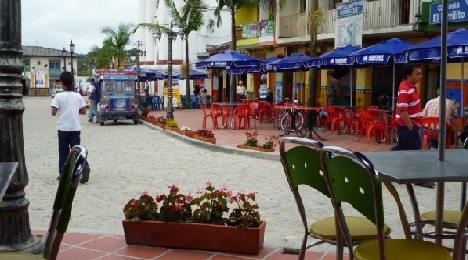
Guatape Plaza From My Coffee Shop
I decided to extend my two month Colombian visa and temporary vehicle import permit by a month with the aim of hopefully finding somewhere in the south of the country to stay for a while and let the wet season come to an end without travelling in it. It isnt difficult travelling in the Central American and Colombian wet season, there are plenty of dry periods each day and areas that dont get much rain anyway but I have followed the wet season south from Guatemala and have been in it for seven months and feel like having a break from the battle to stay dry.
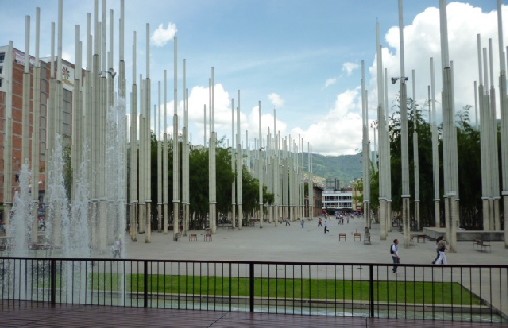
Medellin Plaza Near The DIAN Customs Office
I headed into nearby Medellin, got booked into a hostel with secure off street parking (Casa Kiwi) and took a taxi to the DAS office that handles immigration. I was given a slip of paper with a list of requirements, photocopies, passport photos and instructions to deposit money into a bank but no application form. Photocopies and photos were straight forward and available around the corner from the DAS office but I had to take a taxi to the bank, pay the money, about $38 and receive a receipt. Next I had to get photocopies of the bank receipt and return to the DAS office. On presenting all my paperwork I was handed a form to complete and had to return to the photocopy shop to make a copy of it. With the paperwork finally assembled I was admitted into a waiting room and when it was my turn I was photographed, fingerprinted and told to return the next day to collect the extended visa. The whole process wasnt as bad as I thought it would be, taking about two hours in total. The next morning I was at the DAS office when it opened, waited half an hour and got my passport back with the extra months visa.
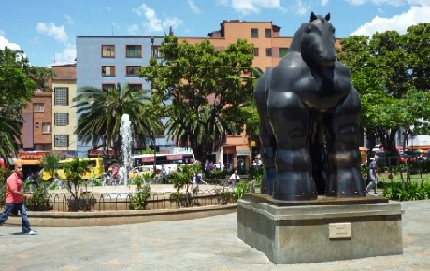
Medellin Plaza
Taking a taxi from the DAS immigration office to the DIAN (customs) office to start the process of extending the bike permit I was disheartened to discover the DIAN office was hidden in a huge complex of government buildings in the centre of town. A policewoman gave me directions but when I entered the building I was told that I needed another office in a different building. At that office I was told I needed the first office and I ended up going back and forwards several times until security at the first office allowed me to go to the information desk where I was told I was in the right building and directed me to the office I needed. At the office I was given a form to complete and a list of all the photocopies I needed and told that I would need to bring the bike into an inspection bay in the basement of the building to have the VIN number checked. Id hoped this wouldnt be necessary but knowing Latin American bureaucracy I was disappointed but not surprised. By the time I had completed the form and got the photocopies done it was too late to return to the DIAN office that day but I was there with the bike for opening time the following day. Security wouldnt allow me into the inspection bay saying I needed written permission to enter so I had to park in a nearby car park, walk to the office and try to explain in Spanish that I needed permission to bring the bike into the inspection bay. The person I needed to see wasnt coming in until 11am so I settled down for a three hour wait. Once the paperwork was handed over the officer that had the misfortune of dealing with me helpfully said she would come to the public car park to do the inspection instead of using the inspection bay. Inspection completed I was told to return at 2:30pm the following day to collect the extended bike permit. My poor Spanish had added to the frustration of getting the visa and bike permit extended but it would have still taken the same amount of time, four days in total.
